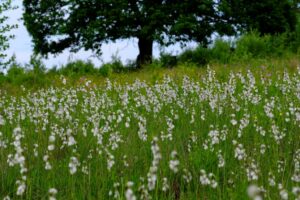In this section we provide short informations about the most important Transylvanian wood-pastures assessed within our project. These informations contains the name of the locality to which the wood-pasture belongs as well as informations about the ecology, history, socio-cultural and economic dimensions of these systems.
Ancient oak wood-pastures can guide oak habitat understanding and restoration
Ancient oak wood-pastures can guide oak habitat understanding and restoration
Habitat restoration in Natura 2000 sites is sometimes a project objective. In this sense, the “restoration of the oak habitat” is most often done under modern forestry interpretation of the term ‘habitat’. 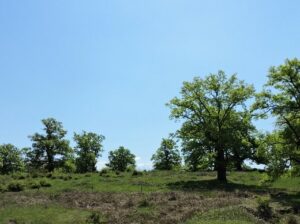 While oak plantations are legitimate from an economic perspective, when talking about ecological restoration of oak habitat or restoring an ecosystem physiognomy naturally characteristic of oak, I would suggest more deliberative discussion and much more trust in the perspectives of ecologists and landscape historians working with oakscapes.
While oak plantations are legitimate from an economic perspective, when talking about ecological restoration of oak habitat or restoring an ecosystem physiognomy naturally characteristic of oak, I would suggest more deliberative discussion and much more trust in the perspectives of ecologists and landscape historians working with oakscapes.
If we aim for oak habitat, it would be worth considering the physiognomy represented by the oak wood-pastures and not that of the high forest as it is conventionally interpreted.
Our suggestions therefore are:
A) If the restoration is done in a land without woody vegetation:
1. Think that the final product of the ecological restoration should be an open landscape with oak and shrubs characteristic of these types of ecosystems.
2. Keep also a genuine grass layer.
3. Introduce dead wood into the system from the surrounding area.
4. In time, also plan for introducing disturbances from large herbivores at some point. These will keep the system open.
5. Be very careful with the rehabilitated system in the first 10-15 years. It is like a patient which is in a recovery from a serious accident. It needs permanent watching, supervision.
B) If the restoration is made from a high forest
1. Determine the density of trees and their specific composition for the desired habitat. Based on this, develop a forest thinning scheme that has various stages implemented over 7-10 years depending on the context.
2. Do not thin suddenly because suddenly exposing mature, old trees to light can be stressful.
3. Take very good care of shrubs, where there are already clumps of shrubs, maintain them so you can make future decisions about them.
4. If you have old living oak trees, prioritize the restoration of their habitats by gradually, not suddenly, opening up the space around them.
5. Keep dead wood in the system (both fallen and “standing”).
6. Calculate the gradual reintroduction of large herbivores.
In both cases, from both directions (A, B, se above) the final product will be something similar to those shown in the pictures associated with this short text. The whole adventure is transdisciplinary. Collaborate with ecologists, agronomists, foresters, no need for tensions.
Large old oak distribution patterns provide a glimpse into landscape history
Large old oak distribution patterns provide a glimpse into landscape history
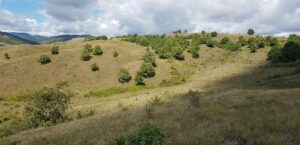 The ancient wood-pasture from Cașolț – Kastenholz – Hermány, commune Roșia, Sibiu county, has an interesting distribution of large old oak trees. Oak trees with a circumference of at least 400 cm are concentrated in the eastern part of the pasture, towards the forest (see map).
The ancient wood-pasture from Cașolț – Kastenholz – Hermány, commune Roșia, Sibiu county, has an interesting distribution of large old oak trees. Oak trees with a circumference of at least 400 cm are concentrated in the eastern part of the pasture, towards the forest (see map).
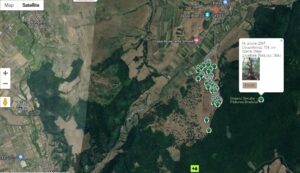 In the forest, however, there is an oak tree 734 cm thick (see the attached map). This distribution of the thick oaks – towards the east of the pasture including the one in the high forest indicate that the old pasture was extended to the east, including the portions that are now forested after abandonment (with hornbeam, beech). Abandonment probably occurred in sequences during periods of local economic instability in past decades.
In the forest, however, there is an oak tree 734 cm thick (see the attached map). This distribution of the thick oaks – towards the east of the pasture including the one in the high forest indicate that the old pasture was extended to the east, including the portions that are now forested after abandonment (with hornbeam, beech). Abandonment probably occurred in sequences during periods of local economic instability in past decades.  Later the new system – the forest – was institutionally “fixed” and the thick oaks inherited from the old pasture, meanwhile dried or weakened by the new forest – were removed. The stumps of the thick oaks as well as that single remained monumental tree you see on the map has a legacy value (historical, cultural, biological). The large old oak in the forest once had a round crown, as is characteristic of oaks that developed in their natural habitat, namely in the meadow.
Later the new system – the forest – was institutionally “fixed” and the thick oaks inherited from the old pasture, meanwhile dried or weakened by the new forest – were removed. The stumps of the thick oaks as well as that single remained monumental tree you see on the map has a legacy value (historical, cultural, biological). The large old oak in the forest once had a round crown, as is characteristic of oaks that developed in their natural habitat, namely in the meadow. 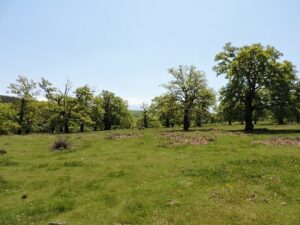 The entire landscape captured by the satellite map should be protected for discovery (through research), for biocultural and historical protection as well as for restoration to the healthy multifunctionality of the local community.
The entire landscape captured by the satellite map should be protected for discovery (through research), for biocultural and historical protection as well as for restoration to the healthy multifunctionality of the local community.
Wood-pasture trees respond to browsing herbivores
Wood-pasture trees respond to browsing herbivores
The ancient wood-pastures of Transylvania evolved under livestock grazing over centuries. Several tree and shrub species show adaptation to herbivore pressure. These adaptations can have multiple forms and in this pill we will present two of them: leaf diversity – foliar polymorphism (size, ‘hardness’) and branch density in the parts exposed to browsing. 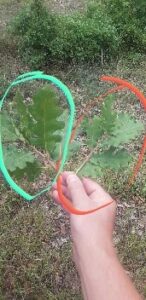 The foliar polymorphism can be didactically visible, as shown in the photos exemplified by downy oak. Leaves at the base of the trees – exposed to goat and cattle – are smaller and harder while the branches are denser than those at heights beyond the browsing lines. Similar phenomena can be noticed in several other trees such are the hornbeam, field maple but also shrubs. This shows that trees and shrubs can respond adaptively to herbivores, they are extremely dynamic and “beauty” in trees is not a certain idealized physiognomy, culturally fixed in humans.
The foliar polymorphism can be didactically visible, as shown in the photos exemplified by downy oak. Leaves at the base of the trees – exposed to goat and cattle – are smaller and harder while the branches are denser than those at heights beyond the browsing lines. Similar phenomena can be noticed in several other trees such are the hornbeam, field maple but also shrubs. This shows that trees and shrubs can respond adaptively to herbivores, they are extremely dynamic and “beauty” in trees is not a certain idealized physiognomy, culturally fixed in humans. 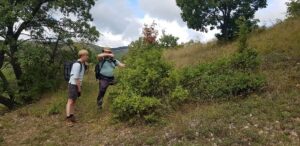 Beauty is the whole spectrum of possible phenotypes and adaptive forms through which trees and shrubs can manifest to navigate certain environmental contexts, such as browsers.
Beauty is the whole spectrum of possible phenotypes and adaptive forms through which trees and shrubs can manifest to navigate certain environmental contexts, such as browsers.
Cotton grass in wood-pasture
Cotton grass in wood-pasture
Cotton grass – Bumbăcarița – Gyapjúsás – Wollgräser is a plant which prefers wet meadows.
If it is present, there are very likely other plant delicatesses present in the habitat, such as various species of orchids, globeflower.
In the meadows of Transylvania existence of Cotton grass depends on traditional mowing and extensive grazing.
Several areas, such as the Mălâncrav Valley, the Criș Valley in the central part of Romania, which had cotton grass patches in the early 2000s were abandoned and other plants, such as reeds, invaded their habitats.
The picture is taken on a wood-pasture near Malnaș – Málnás, Covasna county.
Out of the 120 wood-pastures surveyed for the DBU project, we identified only three sites with small patches of cotton grass, in the humid, marginal parts of the pasture, close to a spring.
